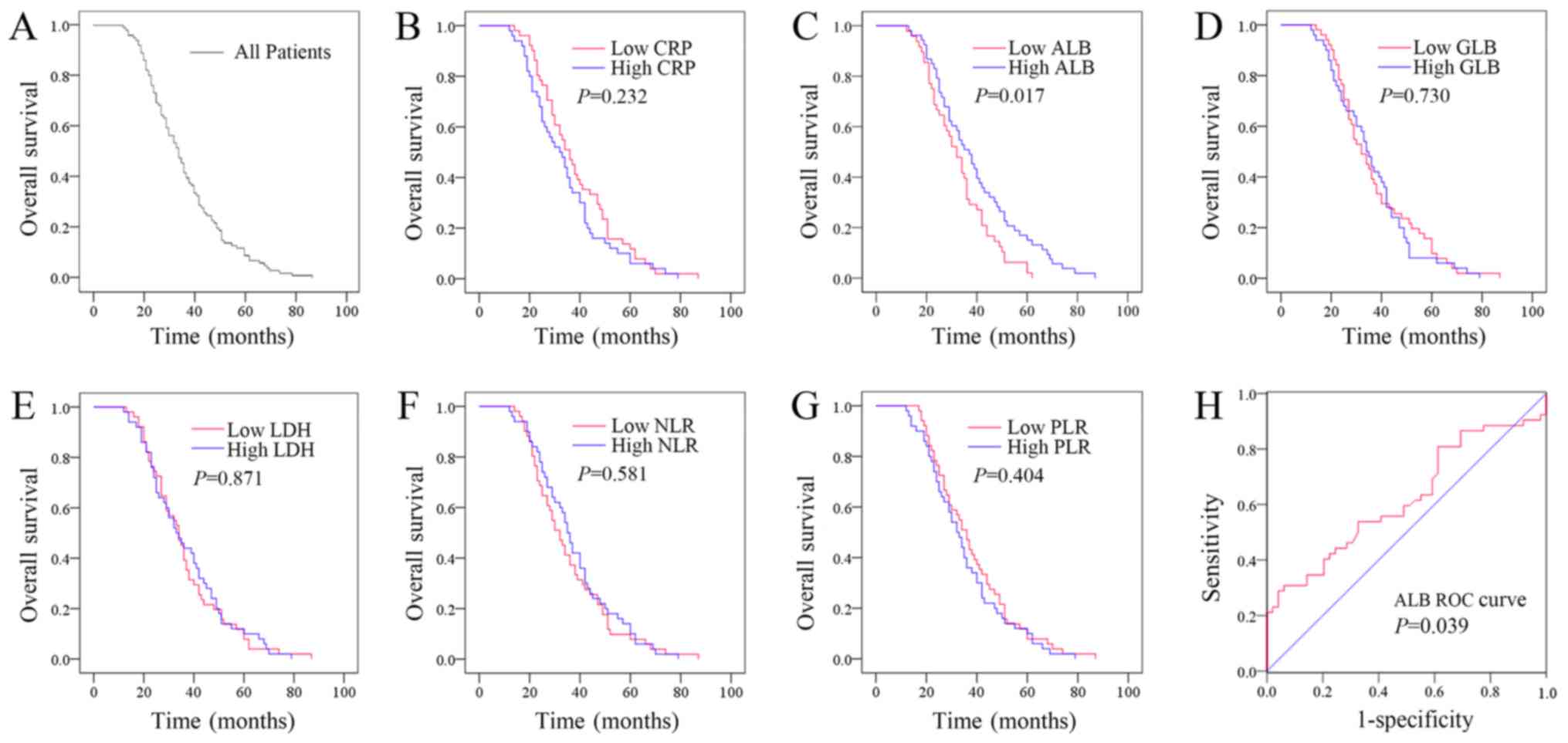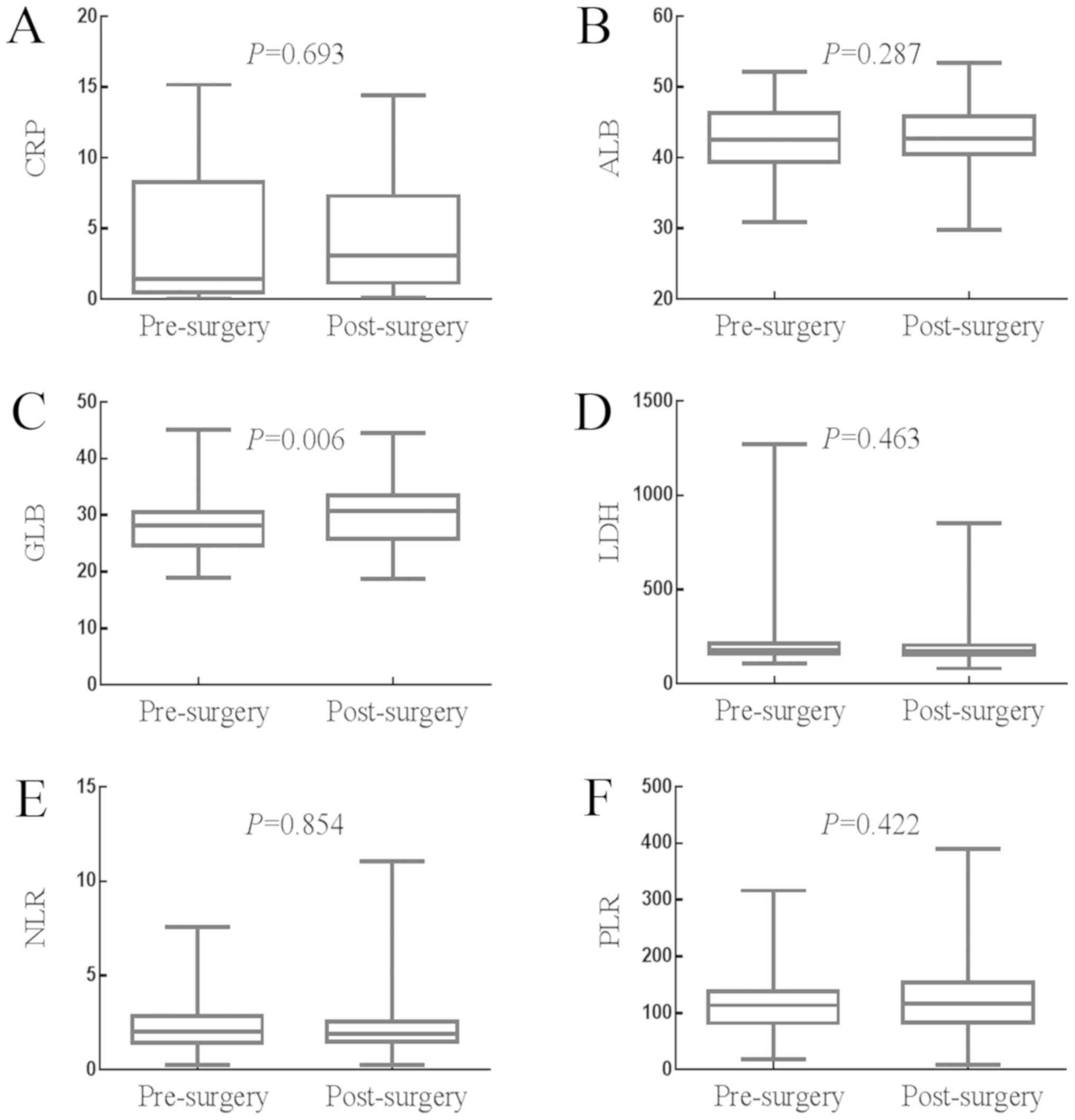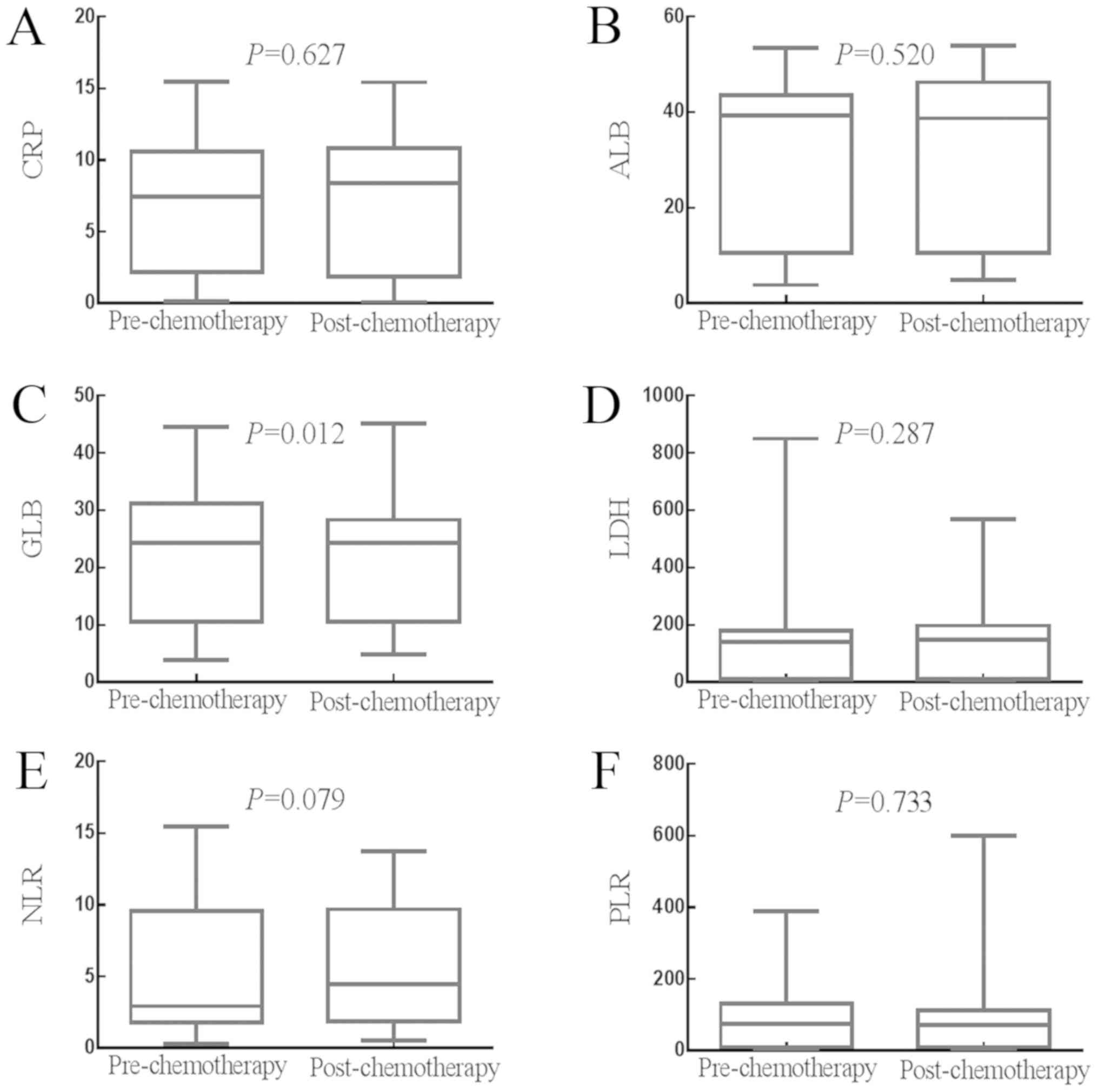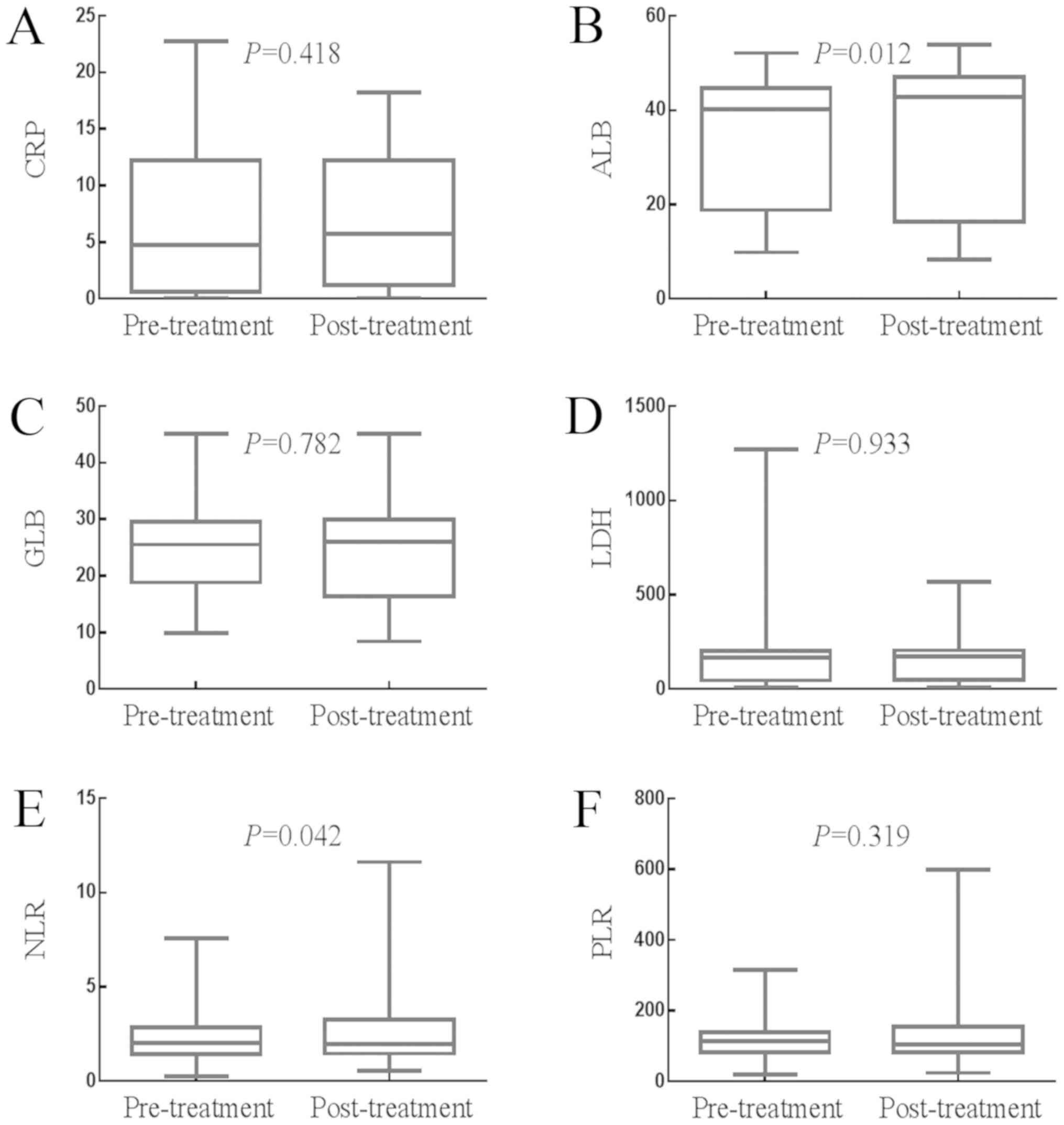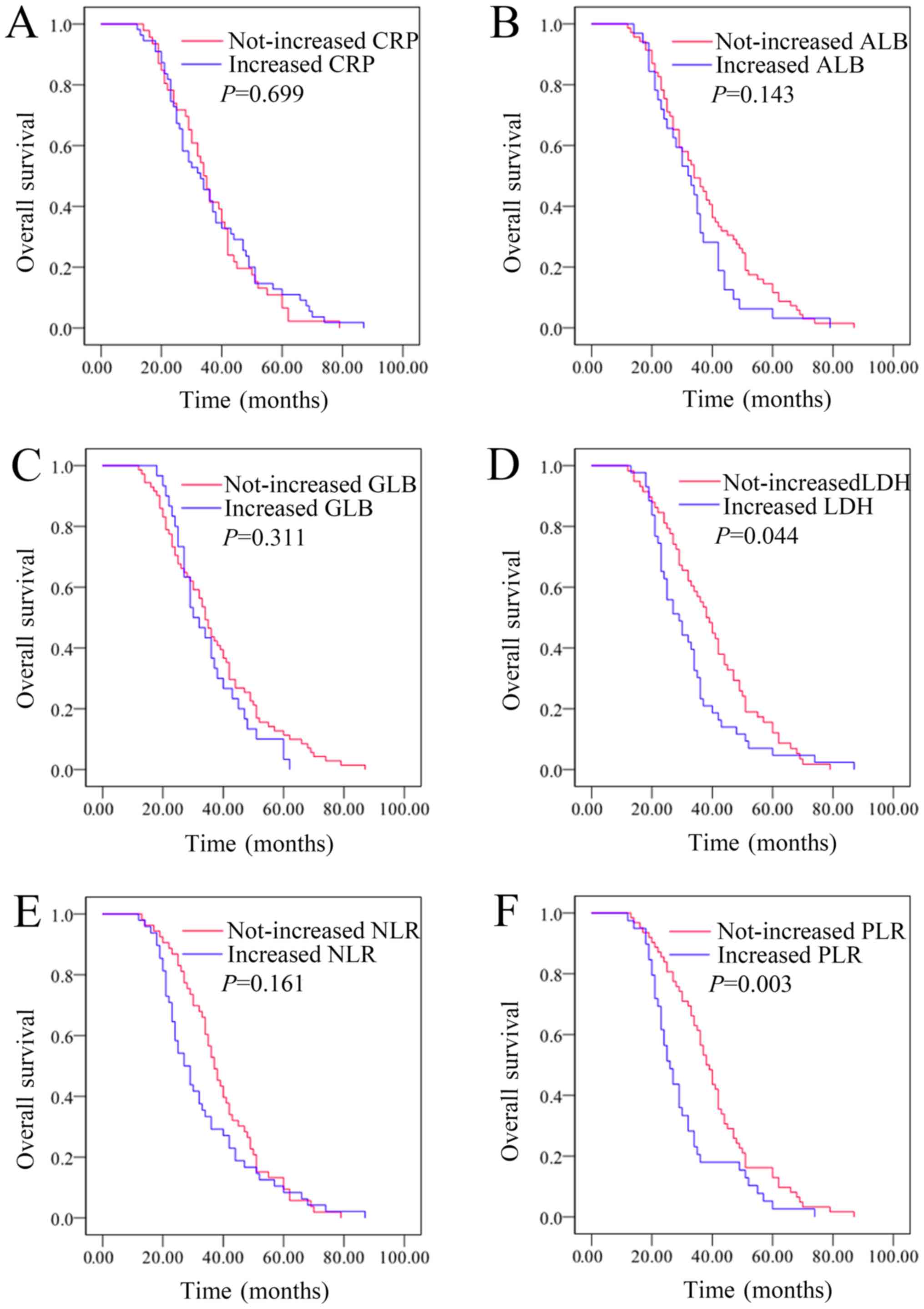|
1
|
Chen W, Zheng R, Baade PD, Zhang S, Zeng
H, Bray F, Jemal A, Yu XQ and He J: Cancer statistics in China,
2015. CA Cancer J Clin. 66:115–132. 2016. View Article : Google Scholar : PubMed/NCBI
|
|
2
|
Hu J, Qian GS and Bai CX: Lung Cancer
Study Group of Chinese Thoracic Society and Chinese Alliance
Against Lung Cancer Expert Group: Chinese consensus on early
diagnosis of primary lung cancer (2014 version). Cancer. 17 Suppl
121:3157–3164. 2015. View Article : Google Scholar
|
|
3
|
Chen W, Zheng R, Zhang S, Zeng H, Xia C,
Zuo T, Yang Z, Zou X and He J: Cancer incidence and mortality in
China, 2013. Cancer Lett. 401:63–71. 2017. View Article : Google Scholar : PubMed/NCBI
|
|
4
|
Huang JY, Jian ZH, Nfor ON, Ku WY, Ko PC,
Lung CC, Ho CC, Pan HH, Huang CY, Liang YC and Liaw YP: The effects
of pulmonary diseases on histologic types of lung cancer in both
sexes: A population-based study in Taiwan. BMC Cancer. 15:8342015.
View Article : Google Scholar : PubMed/NCBI
|
|
5
|
Torre LA, Siegel RL, Ward EM and Jemal A:
Global cancer incidence and mortality rates and trends--an update.
Cancer Epidemiol Biomarkers Prev. 25:16–27. 2016. View Article : Google Scholar : PubMed/NCBI
|
|
6
|
Li S, Lan X, Gao H, Li Z, Chen L, Wang W,
Song S, Wang Y, Li C, Zhang H and Xue Y: Systemic Inflammation
Response Index (SIRI), cancer stem cells and survival of localised
gastric adenocarcinoma after curative resection. J Cancer Res Clin
Oncol. 143:2455–2468. 2017. View Article : Google Scholar : PubMed/NCBI
|
|
7
|
Tong YS, Tan J, Zhou XL, Song YQ and Song
YJ: Systemic immune-inflammation index predicting chemoradiation
resistance and poor outcome in patients with stage III non-small
cell lung cancer. J Transl Med. 15:2212017. View Article : Google Scholar : PubMed/NCBI
|
|
8
|
Feng JF, Chen S and Yang X: Systemic
immune-inflammation index (SII) is a useful prognostic indicator
for patients with squamous cell carcinoma of the esophagus.
Medicine (Baltimore). 96:e58862017. View Article : Google Scholar : PubMed/NCBI
|
|
9
|
Zhong JH, Huang DH and Chen ZY: Prognostic
role of systemic immune-inflammation index in solid tumors: A
systematic review and meta-analysis. Oncotarget. 8:75381–75388.
2017. View Article : Google Scholar : PubMed/NCBI
|
|
10
|
Han LH, Jia YB, Song QX, Wang JB, Wang NN
and Cheng YF: Prognostic significance of preoperative
lymphocyte-monocyte ratio in patients with resectable esophageal
squamous cell carcinoma. Asian Pac J Cancer Prev. 16:2245–2250.
2015. View Article : Google Scholar : PubMed/NCBI
|
|
11
|
Liu X, Meng QH, Ye Y, Hildebrandt MA, Gu J
and Wu X: Prognostic significance of pretreatment serum levels of
albumin, LDH and total bilirubin in patients with non-metastatic
breast cancer. Carcinogenesis. 36:243–248. 2015. View Article : Google Scholar : PubMed/NCBI
|
|
12
|
Tas F, Aydiner A, Demir C and Topuz E:
Serum lactate dehydrogenase levels at presentation predict outcome
of patients with limited-stage small-cell lung cancer. Am J Clin
Oncol. 24:376–378. 2001. View Article : Google Scholar : PubMed/NCBI
|
|
13
|
Gabay C and Kushner I: Acute-phase
proteins and other systemic responses to inflammation. N Engl J
Med. 340:448–454. 1999. View Article : Google Scholar : PubMed/NCBI
|
|
14
|
Groblewska M, Mroczko B,
Wereszczynska-Siemiatkowska U, Kedra B, Lukaszewicz M, Baniukiewicz
A and Szmitkowski M: Serum interleukin 6 (IL-6) and C-reactive
protein (CRP) levels in colorectal adenoma and cancer patients.
Clin Chem Lab Med. 46:1423–1428. 2008. View Article : Google Scholar : PubMed/NCBI
|
|
15
|
Gozlan Y, Ben-Ari Z, Moscona R, Shirazi R,
Rakovsky A, Kabat A, Veizman E, Berdichevski T, Weiss P, Cohen-Ezra
O, et al: HCV genotype-1 subtypes and resistance-associated
substitutions in drug-naive and in direct-acting antiviral
treatment failure patients. Antivir Ther. 22:431–441. 2017.
View Article : Google Scholar : PubMed/NCBI
|
|
16
|
Jurisic V, Radenkovic S and Konjevic G:
The actual role of LDH as tumor marker, biochemical and clinical
aspects. Adv Exp Med Biol. 867:115–124. 2015. View Article : Google Scholar : PubMed/NCBI
|
|
17
|
Yuan C, Li N, Mao X, Liu Z, Ou W and Wang
SY: Elevated pretreatment neutrophil/white blood cell ratio and
monocyte/lymphocyte ratio predict poor survival in patients with
curatively resected non-small cell lung cancer: Results from a
large cohort. Thorac Cancer. 8:350–358. 2017. View Article : Google Scholar : PubMed/NCBI
|
|
18
|
Toda M, Tsukioka T, Izumi N, Komatsu H,
Okada S, Hara K, Miyamoto H, Ito R, Shibata T and Nishiyama N:
Platelet-to-lymphocyte ratio predicts the prognosis of patients
with non-small cell lung cancer treated with surgery and
postoperative adjuvant chemotherapy. Thorac Cancer. 9:112–119.
2018. View Article : Google Scholar : PubMed/NCBI
|
|
19
|
Lorente D, Mateo J, Templeton AJ,
Zafeiriou Z, Bianchini D, Ferraldeschi R, Bahl A, Shen L, Su Z,
Sartor O and de Bono JS: Baseline neutrophil-lymphocyte ratio (NLR)
is associated with survival and response to treatment with
second-line chemotherapy for advanced prostate cancer independent
of baseline steroid use. Ann Oncol. 26:750–755. 2015. View Article : Google Scholar : PubMed/NCBI
|
|
20
|
Shen L, Zhang H, Liang L, Li G, Fan M, Wu
Y, Zhu J and Zhang Z: Baseline neutrophil-lymphocyte ratio
(>/=2.8) as a prognostic factor for patients with locally
advanced rectal cancer undergoing neoadjuvant chemoradiation.
Radiat Oncol. 9:2952014. View Article : Google Scholar : PubMed/NCBI
|
|
21
|
Edge SB and Compton CC: The american joint
committee on cancer: The 7th edition of the AJCC cancer staging
manual and the future of TNM. Ann Surg Oncol. 17:1471–1474. 2010.
View Article : Google Scholar : PubMed/NCBI
|
|
22
|
Eisenhauer EA, Therasse P, Bogaerts J,
Schwartz LH, Sargent D, Ford R, Dancey J, Arbuck S, Gwyther S,
Mooney M, et al: New response evaluation criteria in solid tumours:
Revised RECIST guideline (version 1.1). Eur J Cancer. 45:228–247.
2009. View Article : Google Scholar : PubMed/NCBI
|
|
23
|
Mantovani A, Allavena P, Sica A and
Balkwill F: Cancer-related inflammation. Nature. 454:436–444. 2008.
View Article : Google Scholar : PubMed/NCBI
|
|
24
|
Diakos CI, Charles KA, McMillan DC and
Clarke SJ: Cancer-related inflammation and treatment effectiveness.
Lancet Oncol. 15:e493–503. 2014. View Article : Google Scholar : PubMed/NCBI
|
|
25
|
Proctor MJ, Morrison DS, Talwar D, Balmer
SM, O'Reilly DS, Foulis AK, Horgan PG and McMillan DC: An
inflammation-based prognostic score (mGPS) predicts cancer survival
independent of tumour site: A glasgow inflammation outcome study.
Br J Cancer. 104:726–734. 2011. View Article : Google Scholar : PubMed/NCBI
|
|
26
|
Wilson DO, Weissfeld JL, Balkan A,
Schragin JG, Fuhrman CR, Fisher SN, Wilson J, Leader JK, Siegfried
JM, Shapiro SD and Sciurba FC: Association of radiographic
emphysema and airflow obstruction with lung cancer. Am J Respir
Crit Care Med. 178:738–744. 2008. View Article : Google Scholar : PubMed/NCBI
|
|
27
|
Wasswa-Kintu S, Gan WQ, Man SF, Pare PD
and Sin DD: Relationship between reduced forced expiratory volume
in one second and the risk of lung cancer: A systematic review and
meta-analysis. Thorax. 60:570–575. 2005. View Article : Google Scholar : PubMed/NCBI
|
|
28
|
Ng Kee Kwong F, Nicholson AG, Harrison CL,
Hansbro PM, Adcock IM and Chung KF: Is mitochondrial dysfunction a
driving mechanism linking COPD to nonsmall cell lung carcinoma? Eur
Respir Rev. 26:1700402017. View Article : Google Scholar : PubMed/NCBI
|
|
29
|
Dye JA and Adler KB: Effects of cigarette
smoke on epithelial cells of the respiratory tract. Thorax.
49:825–834. 1994. View Article : Google Scholar : PubMed/NCBI
|
|
30
|
Sopori M: Effects of cigarette smoke on
the immune system. Nat Rev Immunol. 2:372–377. 2002. View Article : Google Scholar : PubMed/NCBI
|
|
31
|
Houghton AM: Mechanistic links between
COPD and lung cancer. Nat Rev Cancer. 13:233–245. 2013. View Article : Google Scholar : PubMed/NCBI
|
|
32
|
Marnett LJ: Oxyradicals and DNA damage.
Carcinogenesis. 21:361–370. 2000. View Article : Google Scholar : PubMed/NCBI
|
|
33
|
Gu X, Sun S, Gao XS, Xiong W, Qin S, Qi X,
Ma M, Li X, Zhou D, Wang W and Yu H: Prognostic value of platelet
to lymphocyte ratio in non-small cell lung cancer: Evidence from
3,430 patients. Sci Rep. 6:238932016. View Article : Google Scholar : PubMed/NCBI
|
|
34
|
Koh CH, Bhoo-Pathy N, Ng KL, Jabir RS, Tan
GH, See MH, Jamaris S and Taib NA: Utility of pre-treatment
neutrophil-lymphocyte ratio and platelet-lymphocyte ratio as
prognostic factors in breast cancer. Br J Cancer. 113:150–158.
2015. View Article : Google Scholar : PubMed/NCBI
|
|
35
|
Li Y, Wang C, Xu M, Kong C, Qu A, Zhang M,
Zheng Z and Zhang G: Preoperative NLR for predicting survival rate
after radical resection combined with adjuvant immunotherapy with
CIK and postoperative chemotherapy in gastric cancer. J Cancer Res
Clin Oncol. 143:861–871. 2017. View Article : Google Scholar : PubMed/NCBI
|
|
36
|
Hara M, Matsuzaki Y, Shimuzu T, Tomita M,
Ayabe T, Enomoto Y and Onitsuka T: Preoperative serum C-reactive
protein level in non-small cell lung cancer. Anticancer Res.
27:3001–3004. 2007.PubMed/NCBI
|
|
37
|
Lee JG, Cho BC, Bae MK, Lee CY, Park IK,
Kim DJ, Ahn SV and Chung KY: Preoperative C-reactive protein levels
are associated with tumor size and lymphovascular invasion in
resected non-small cell lung cancer. Lung Cancer. 63:106–110. 2009.
View Article : Google Scholar : PubMed/NCBI
|
|
38
|
Alifano M, Falcoz PE, Seegers V, Roche N,
Schussler O, Younes M, Antonacci F, Forgez P, Dechartres A, Massard
G, et al: Preresection serum C-reactive protein measurement and
survival among patients with resectable non-small cell lung cancer.
J Thorac Cardiovasc Surg. 142:1161–1167. 2011. View Article : Google Scholar : PubMed/NCBI
|
|
39
|
Yeun JY and Kaysen GA: Factors influencing
serum albumin in dialysis patients. Am J kidney Dis. 32 Suppl
4:S118–S125. 1998. View Article : Google Scholar : PubMed/NCBI
|
|
40
|
Okumura H, Uchikado Y, Setoyama T,
Matsumoto M, Owaki T, Ishigami S and Natsugoe S: Biomarkers for
predicting the response of esophageal squamous cell carcinoma to
neoadjuvant chemoradiation therapy. Surg Today. 44:421–428. 2014.
View Article : Google Scholar : PubMed/NCBI
|
|
41
|
Lu CY, Uen YH, Tsai HL, Chuang SC, Hou MF,
Wu DC, Juo SH, Lin SR and Wang JY: Molecular detection of
persistent postoperative circulating tumour cells in stages II and
III colon cancer patients via multiple blood sampling: Prognostic
significance of detection for early relapse. Br J Cancer.
104:1178–1184. 2011. View Article : Google Scholar : PubMed/NCBI
|
|
42
|
Gupta D and Lis CG: Pretreatment serum
albumin as a predictor of cancer survival: A systematic review of
the epidemiological literature. Nutr J. 9:692010. View Article : Google Scholar : PubMed/NCBI
|
|
43
|
Tolia M, Tsoukalas N, Kyrgias G, Mosa E,
Maras A, Kokakis I, Liakouli Z, Kouvaris JR, Liaskonis K,
Charalampakis N, et al: Prognostic significance of serum
inflammatory response markers in newly diagnosed non-small cell
lung cancer before chemoirradiation. BioMed Res Int.
2015:4857322015. View Article : Google Scholar : PubMed/NCBI
|
|
44
|
Jin Y, Zhao L and Peng F: Prognostic
impact of serum albumin levels on the recurrence of stage I
non-small cell lung cancer. Clinics (Sao Paulo). 68:686–693. 2013.
View Article : Google Scholar : PubMed/NCBI
|
|
45
|
Chen J, Zhou Y, Xu Y, Zhu HY and Shi YQ:
Low pretreatment serum globulin may predict favorable prognosis for
gastric cancer patients. Tumour Biol. 37:3905–3911. 2016.
View Article : Google Scholar : PubMed/NCBI
|
|
46
|
Qu X, Pang Z, Yi W, Wang Y, Wang K, Liu Q
and Du J: High percentage of α1-globulin in serum protein is
associated with unfavorable prognosis in non-small cell lung
cancer. Med Oncol. 31:2382014. View Article : Google Scholar : PubMed/NCBI
|
|
47
|
Higashiyama M, Doi O, Kodama K, Yokouchi H
and Tateishi R: An evaluation of the prognostic significance of
alpha-1-antitrypsin expression in adenocarcinomas of the lung: An
immunohistochemical analysis. Br J Cancer. 65:300–302. 1992.
View Article : Google Scholar : PubMed/NCBI
|
|
48
|
Tas F, Karabulut S, Ciftci R, Sen F, Sakar
B, Disci R and Duranyildiz D: Serum levels of LDH, CEA, and CA19-9
have prognostic roles on survival in patients with metastatic
pancreatic cancer receiving gemcitabine-based chemotherapy. Cancer
Chemother Pharmacol. 73:1163–1171. 2014. View Article : Google Scholar : PubMed/NCBI
|
|
49
|
Yin C, Jiang C, Liao F, Rong Y, Cai X, Guo
G, Qiu H, Chen X, Zhang B, He W and Xia L: Initial LDH level can
predict the survival benefit from bevacizumab in the first-line
setting in chinese patients with metastatic colorectal cancer.
OncoTargets Ther. 7:1415–1422. 2014. View Article : Google Scholar
|
|
50
|
Vander Heiden MG, Cantley LC and Thompson
CB: Understanding the warburg effect: The metabolic requirements of
cell proliferation. Science. 324:1029–1033. 2009. View Article : Google Scholar : PubMed/NCBI
|
|
51
|
Sun X, Sun Z, Zhu Z, Guan H, Zhang J,
Zhang Y, Xu H and Sun M: Clinicopathological significance and
prognostic value of lactate dehydrogenase A expression in gastric
cancer patients. PLoS One. 9:e910682014. View Article : Google Scholar : PubMed/NCBI
|
|
52
|
Harris AL: Hypoxia-a key regulatory factor
in tumour growth. Nat Rev Cancer. 2:38–47. 2002. View Article : Google Scholar : PubMed/NCBI
|
|
53
|
Azuma M, Shi M, Danenberg KD, Gardner H,
Barrett C, Jacques CJ, Sherod A, Iqbal S, El-Khoueiry A, Yang D, et
al: Serum lactate dehydrogenase levels and glycolysis significantly
correlate with tumor VEGFA and VEGFR expression in metastatic CRC
patients. Pharmacogenomics. 8:1705–1713. 2007. View Article : Google Scholar : PubMed/NCBI
|
|
54
|
Koukourakis MI, Giatromanolaki A,
Simopoulos C, Polychronidis A and Sivridis E: Lactate dehydrogenase
5 (LDH5) relates to up-regulated hypoxia inducible factor pathway
and metastasis in colorectal cancer. Clin Exp Metastasis. 22:25–30.
2005. View Article : Google Scholar : PubMed/NCBI
|
|
55
|
Toffoli S and Michiels C: Intermittent
hypoxia is a key regulator of cancer cell and endothelial cell
interplay in tumours. FEBS J. 275:2991–3002. 2008. View Article : Google Scholar : PubMed/NCBI
|
|
56
|
Lu H, Forbes RA and Verma A:
Hypoxia-inducible factor 1 activation by aerobic glycolysis
implicates the Warburg effect in carcinogenesis. J Biol Chem.
277:23111–23115. 2002. View Article : Google Scholar : PubMed/NCBI
|
|
57
|
Koh YW, Lee SJ and Park SY: Prognostic
significance of lactate dehydrogenase B according to histologic
type of non-small-cell lung cancer and its association with serum
lactate dehydrogenase. Pathol Res Pract. 213:1134–1138. 2017.
View Article : Google Scholar : PubMed/NCBI
|
|
58
|
Harimoto N, Shirabe K, Nakagawara H,
Toshima T, Yamashita Y, Ikegami T, Yoshizumi T, Soejima Y, Ikeda T
and Maehara Y: Prognostic factors affecting survival at recurrence
of hepatocellular carcinoma after living-donor liver
transplantation: with special reference to neutrophil/lymphocyte
ratio. Transplantation. 96:1008–1012. 2013. View Article : Google Scholar : PubMed/NCBI
|
|
59
|
Tanaka N, Kikuchi E, Kanao K, Matsumoto K,
Shirotake S, Miyazaki Y, Kobayashi H, Kaneko G, Hagiwara M, Ide H,
et al: A multi-institutional validation of the prognostic value of
the neutrophil-to-lymphocyte ratio for upper tract urothelial
carcinoma treated with radical nephroureterectomy. Ann surg Oncol.
21:4041–4048. 2014. View Article : Google Scholar : PubMed/NCBI
|
|
60
|
Jin H, Zhang G, Liu X, Liu X, Chen C, Yu
H, Huang X, Zhang Q and Yu J: Blood neutrophil-lymphocyte ratio
predicts survival for stages III–IV gastric cancer treated with
neoadjuvant chemotherapy. World J Surg Oncol. 11:1122013.
View Article : Google Scholar : PubMed/NCBI
|
|
61
|
Choi JE, Villarreal J, Lasala J,
Gottumukkala V, Mehran RJ, Rice D, Yu J, Feng L and Cata JP:
Perioperative neutrophil:Lymphocyte ratio and postoperative NSAID
use as predictors of survival after lung cancer surgery: A
retrospective study. Cancer Med. 4:825–833. 2015. View Article : Google Scholar : PubMed/NCBI
|
|
62
|
Goubran HA, Burnouf T, Radosevic M and
El-Ekiaby M: The platelet-cancer loop. Eur J Intern Med.
24:393–400. 2013. View Article : Google Scholar : PubMed/NCBI
|
|
63
|
Jeong E, Hyun SH, Moon SH, Cho YS, Kim BT
and Lee KH: Relation between tumor FDG uptake and hematologic
prognostic indicators in stage I lung cancer patients following
curative resection. Medicine (Baltimore). 96:e59352017. View Article : Google Scholar : PubMed/NCBI
|
|
64
|
Sanchez-Salcedo P, de-Torres JP,
Martinez-Urbistondo D, Gonzalez-Gutierrez J, Berto J, Campo A,
Alcaide AB and Zulueta JJ: The neutrophil to lymphocyte and
platelet to lymphocyte ratios as biomarkers for lung cancer
development. Lung Cancer. 97:28–34. 2016. View Article : Google Scholar : PubMed/NCBI
|
|
65
|
Nikolic I, Kukulj S, Samaržija M, Jeleč V,
Žarak M, Orehovec B, Taradi I, Romić D, Kolak T and Patrlj L:
Neutrophil-to-lymphocyte and platelet-to-lymphocyte ratio help
identify patients with lung cancer, but do not differentiate
between lung cancer subtypes. Croat Med J. 57:287–292. 2016.
View Article : Google Scholar : PubMed/NCBI
|
|
66
|
Dunn GP, Old LJ and Schreiber RD: The
immunobiology of cancer immunosurveillance and immunoediting.
Immunity. 21:137–148. 2004. View Article : Google Scholar : PubMed/NCBI
|
|
67
|
Ohtani H: Focus on TILs: Prognostic
significance of tumor infiltrating lymphocytes in human colorectal
cancer. Cancer Immun. 7:42007.PubMed/NCBI
|
|
68
|
Dirican N, Dirican A, Anar C, Atalay S,
Ozturk O, Bircan A, Akkaya A and Cakir M: A new inflammatory
prognostic index, based on C-reactive protein, the neutrophil to
lymphocyte ratio and serum albumin is useful for predicting
prognosis in non-small cell lung cancer cases. Asian Pac J Cancer
Prev. 17:5101–5106. 2016.PubMed/NCBI
|
|
69
|
Suzuki K, Aiura K, Ueda M and Kitajima M:
The influence of platelets on the promotion of invasion by tumor
cells and inhibition by antiplatelet agents. Pancreas. 29:132–140.
2004. View Article : Google Scholar : PubMed/NCBI
|
|
70
|
Sabrkhany S, Griffioen AW and Oude Egbrink
MG: The role of blood platelets in tumor angiogenesis. Biochim
Biophys Acta. 1815:189–196. 2011.PubMed/NCBI
|
|
71
|
Kim YJ, Borsig L, Varki NM and Varki A:
P-selectin deficiency attenuates tumor growth and metastasis. Proc
Natl Acad Sci U S A. 95:9325–9330. 1998. View Article : Google Scholar : PubMed/NCBI
|
|
72
|
Nieswandt B, Hafner M, Echtenacher B and
Mannel DN: Lysis of tumor cells by natural killer cells in mice is
impeded by platelets. Cancer Res. 59:1295–1300. 1999.PubMed/NCBI
|
|
73
|
Maini MK and Schurich A: Platelets harness
the immune response to drive liver cancer. Proc Natl Acad Sci U S
A. 109:12840–12841. 2012. View Article : Google Scholar : PubMed/NCBI
|















